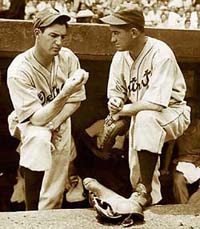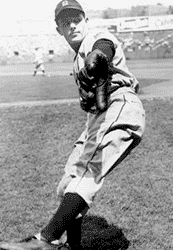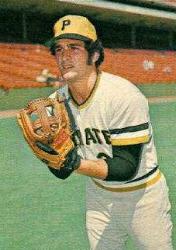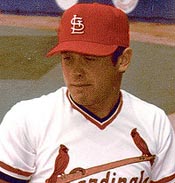CONTENTS
Harmon's First HR
Feller's Debut
Heads-Up Triple Play
Game Stopped by a Fight
An Old Horse Helps Old Hoss
Infield Fly Confusion
Tiger Farewell to Mickey
Germany Calls His Shot
I'm Not Just Your Manager Now
What a Way to Lose
Baseball Lore –
II
Baseball Lore – III
Baseball
Lore – IV
Baseball
Lore – V
Baseball
Lore – VI
Baseball
Lore – VII
Baseball
Lore – VIII
Baseball
Lore – IX
Baseball
Lore – X
Baseball
Page
Golden Rankings Home
Top of Page
|
Bits
of Baseball Lore – I
Harmon's First HR
Harmon
Killebrew on his first homer in the majors (Sporting
News, 5/28/07):
I
was 18 years old, playing in old Griffith Stadium in Washington (June 24,
1955). Billy Hoeft was pitching, and Frank House
was catching. He told me, "Kid, we're going to throw you a fastball."
Being so young, I didn't know whether to believe him or not. But the pitch
came, it was a fastball and I hit it 476 feet. When I crossed home, House
said, "Kid, that's the only time we're going to tell you what's coming."
Feller's Debut
Bob
Feller signed with the Cleveland
Indians at age 16. He joined the club in 1936 as a 17-year
old. In a spring training game against the St.
Louis Cardinals, two years removed from the championship,
he struck out eight of the nine batters he faced. In his first start of his
major league career, he struck out 15 St. Louis
Browns. He topped that three weeks later with 17 K's against
the Philadelphia Athletics.
Several weeks after that, he went back to Van Meter IA to graduate from high
school. Furthermore, his graduation was broadcast across the nation by
NBC. In The
Stark Truth:The Most Overrated and Underrated Players in Baseball History,
ESPN's Jayson Stark ranks Feller as the
most underrated right-handed starter of all time.
Heads-Up Triple Play
September 7,
1935: Fenway Park, Cleveland
vs Boston
Red Sox have the bases loaded
in bottom of ninth with none out with manager-shortstop Joe
Cronin at bat against Oral Hildebrand. Cronin
lines a pitch toward 3B Odell Hale. The ball caroms off Hale's
forehead on the fly to SS Bill Knickerbocker. Bill
throws to Roy Hughes at second for the second out, and Hughes
relays to Hal Trotsky at first to complete the "heads-up"
triple play and end the game. (Baseball Digest August 2007)
Game Stopped by a Fight
June
18, 1941 [3 days before Golden's birth]: New
York Giants @ Pittsburgh Pirates
in a night game at Forbes Field
In the third inning, the game was interrupted for a 56-minute radio broadcast
of the Billy
Conn-Joe
Louis heavyweight championship match. Conn,
a native son of the Steel City, lost in 15 rounds after which the game continued.
As far as is known, this is the only time in MLB history that a game was interrupted
in this way.
The teams battled 11 innings to a 2-2 tie before a crowd of 24,000. National
League rules decreed that no inning could start after 11:50 pm. Mel
Ott hit his 17th HR of year for the Giants
and Bob Elliott drove in both Pirate
runs in the first inning with a triple. Other well-known players in the game:
Giants – Dick
Bartell SS, Burgess Whitehead 2B; Pirates
– Arky
Vaughan SS, Vince DiMaggio (Joe's
brother) CF, Al
Lopez C. (Baseball
Digest August 2007)
An Old Horse Helps Old Hoss
In
1882, Charles Radbourn was playing at home for Providence.
Known more for his pitching than his hitting (he won 59 games in 1884), he
crushed a pitch to left field. The ball dropped and rolled toward a line of
carriages that formed the de facto boundary, coming to rest near a horse.
When the outfielder, Detroit's
George Wood, reached for the ball, the beast kicked. Wood
tried again; the horse kicked again. Radbourn, whose nickname,
appropriately, was Old Hoss, kept running around the bases.
Wood tried to distract the horse with grass. No luck. Finally,
another outfielder poked out the ball with a stick, by which time Old
Hoss was headed for the barn.
Reference: Crazy
'08: How a Cast of Cranks, Rogues, Boneheads, and Magnates Created the Greatest
Year in Baseball History, by Cait Murphy [Highly recommended]
Infield Fly Confusion
July
25, 1961 – Cubs at bat
in the second inning vs Cardinals.
Ron Santo on second base and Jerry Kindall
on first when Ed Bouchee hit a pop fly. With fewer than two
out, the infield fly rule was in effect; so Bouchee was out.
However, Cardinals 2B Julian
Javier intentionally dropped the ball. According to the rules, the
baserunners may advance at their own risk, and Santo took
the bait. Javier fired the ball to Ken Boyer,
who stepped on third base, although he was required to tag Santo
since the force was removed by the batter's retirement. Santo,
21 years old in his second big league season, headed for the dugout thinking
he was out. Cardinal pitcher
Ray Sadecki shouted to Boyer, who tagged
Santo when he tried to return to third base after his teammates
alerted him.
Reference:
Baseball Digest, August 2007
Tiger Farewell to Mickey
The
Detroit Tigers hosted the New
York Yankees on September 19,
1968. Denny McLain, who had won his 30th game five days earlier
for the Tigers,
who had already clinched the AL pennant, was cruising along in the top of
the eighth inning with a 6-1 lead. Mickey
Mantle came to bat with one out and nobody on. Mickey
had already announced his retirement at the end of the season. This was his
last at-bat in Tiger Stadium. So McLain let Mantle
know that he would give him whatever pitch Mickey wanted.
Mantle signaled for a fastball letter high. McClain
threw what he requested, and Mantle swatted it into the right
field seats for his 535th career home run. In the broadcast booth, Ernie
Harwell figured out what was happening. "I think he's trying
to tell Mantle to hit one out." After the game, McLain
was coy about giving Mantle a fat pitch. However, it was
obvious that he did so on purpose. Mickey hit one more HR
before the season ended for a final total with 536 for his career.
Reference:
Baseball Digest August 2007
Germany Calls His Shot
Herman
"Germany" Schaefer was a journeyman second baseman
for Detroit from 1905-9.
Called "The Prince" because of his showmanship,
he is famous for several novel incidents. We'll devote this Bit of Baseball
Lore to what he did on June 24, 1906.
Before
a home crowd whom he loved to entertain, he pinch hit with two outs
in the ninth, with a man on base, and the Tigers
trailing by a run. He supposedly announced to the crowd: "Ladies
and gentlemen, you are now looking at Herman Schaefer,
better known as "Herman the Great," acknowledged
by one and all to be the greatest pinch-hitter in the world. I am now
going to hit the ball into the left field bleachers. Thank you."
He
then did precisely that, hitting the game-winning homer on the first
pitch from Chicago's Doc
White. Many years later, teammate Davy Jones
related that Schaefer slid into every base on his way
around the diamond, announcing his progress as if it were a horse race.
"Schaefer leads at the half!" After hook-sliding
into home, he doffed his cap, bowed, and said, "Ladies and gentlemen,
this concludes the afternoon's performance. I thank you for your kind
attention." Newspaper accounts of the game confirm the basic details
but do not include all the embellishments offered by Jones.
|

Germany Schaefer
|
Reference: Deadball Stars of the American League, The Society for
American Baseball Research
I'm Not Just Your Manager Now

Schoolboy Rowe and Mickey Cochrane

Rowe and Cochrane in 1944

Virgil Trucks
|
C Mickey Cochrane and P Lynwood "Schoolboy" Rowe formed an outstanding battery for Detroit from 1934-37.
- Rowe won 43 games in 1934 and 1935 as the Tigers won the pennant in both years.
- Cochrane was the player-manager of the team through the '37 season when he suffered a triple skull fracture from a beaning that ended his playing career. He served one more year as skipper before being replaced.
Eventually, Cochrane and Rowe hooked up again in the Navy during World War II.
- Mickey was commissioned a Lieutenant in the U.S. Navy on April 1, 1942, and appointed Baseball Officer at the Great Lakes Naval Training Center on Lake Michigan. He organized and managed a powerful team that consisted almost entirely of former professionals. They played a full schedule against major and minor league teams and college and semipro nines.
- After pitching for the Philadelphia Blue Jays (yes, that was their official name that season), Rowe was inducted into the Navy and assigned to Great Lakes where Cochrane became not only his manager but also his military superior.
Cochrane took advantage of his extra authority on several occasions.
- On July 5, 1944, Great Lakes played the Ford Motors All Stars in Dearborn MI. To everyone's surprise the hometown team led 1-0 going into the ninth before the Bluejackets plated a run to tie. Cochrane, who rarely played but pinch hit in the top of the inning, put himself behind the plate to catch Rowe. After retiring the first batter, Schoolboy inexplicably threw a Rip Sewell-like blooper ball to the next batter who deposited it beyond the fence for a game-winning HR. Virgil Trucks, another former Tiger P on the Great Lakes team, recalled: "I thought Cochrane was going to kill Rowe when we got on the bus to leave. Cochrane said to Rowe, 'I don't know if I will catch another time. But if I do and I call for a fast ball and you throw that Sewell Blooper pitch, I'll send you so far overseas you'll never get back!" The loss was one of only two against 48 victories for Great Lakes that year.
- On August 7, the Bluejackets hosted the Chicago White Sox. Before the game, Cochrane and Rowe visited with opponents they knew. Rowe, a native of Waco TX, complained about the cool weather at Great Lakes at the beginning of the season. Eddie Carnett, White Sox OF, recalled the banter: "Mickey was laughing at Schoolboy. He said he wanted him to pitch a game, and Rowe said his arm didn't feel good and couldn't do too good in that cold weather. ... Mickey says, 'Well, they tell me it's pretty damn warm down in the South Pacific.' Then Schoolboy says, 'I'll pitch.'" A good hitter, Rowe played OF that day. Trucks (who should be mentioned with the likes of Ted Williams and Bob Feller in discussions of players whose careers were severely affected by World War II) threw a two-hit shutout, 1-0.
Question: Why was Rowe called "Schoolboy"?
Answer: He received his nickname while playing on a men's team as a fifteen-year-old high school student.
Reference: Bluejackets of Summer, Roger S. Gogan
|
|
|

Bob Moose

Glenn Brummer
|
- June 26, 1930: Forbes Field, Pittsburgh. The Pirates defeat the Phillies 1-0. The only run scores in the third inning when P Phil Collins drops the ball during his windup with a man on third.
- September 29, 1959: Los Angeles Coliseum. Game 2 of the NL playoff is tied in the bottom of the 12th. Dodger Gil Hodges scores the winning run when Milwaukee Braves 2B Felix Mantilla fields Carl Furillo's grounder and throws it away.
- October 11, 1972: Riverfront Stadium, Cincinnati. The 5th and final game of the NLCS between the Pirates and Reds is tied in the bottom of the ninth after C Johnny Bench greets reliever Dave Giusti with a solo HR. After surrendering singles to Tony Perez and Denis Menke, Giusti gives way to Bob Moose. Pinch runner George Foster advances to third on Cesar Geronimo's flyout to RF. But SS Darrel Chaney pops out to SS. With Hal McRae at the plate, Moose uncorks a wild pitch that allows Foster to cross the plate with the run that sends the Reds to the World Series.
- August 22, 1982: Busch Stadium, St. Louis. The game is tied at 4 in the bottom of the 12th with two outs, the bases loaded, and David Green at the plate. Backup C Glenn Brummer steals home on Giants P Gary Lavelle – a rare walk-off steal of home.
More collections of these to come.
|

Felix Mantilla
|
|
|






